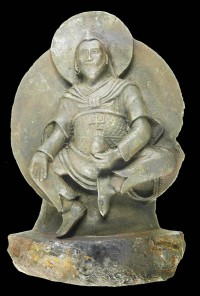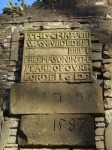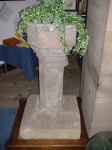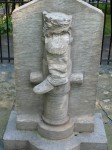 Not the meteorite part. The figure was definitely carved from a piece of the Chinga meteorite which fell near the Mongolian-Siberian border 15,000 years ago. It’s the part about it being an 11th century Bön culture artifact that is suspect, and, even more sadly, the part about it having been found during Ernst Schäfer’s Tibet expedition. Buddhism expert Achim Bayer from Dongguk University in South Korea argues persuasively in this article (pdf) that the statue’s features mark it as a European counterfeit probably made between 1910 and 1970.
Not the meteorite part. The figure was definitely carved from a piece of the Chinga meteorite which fell near the Mongolian-Siberian border 15,000 years ago. It’s the part about it being an 11th century Bön culture artifact that is suspect, and, even more sadly, the part about it having been found during Ernst Schäfer’s Tibet expedition. Buddhism expert Achim Bayer from Dongguk University in South Korea argues persuasively in this article (pdf) that the statue’s features mark it as a European counterfeit probably made between 1910 and 1970.
Bayer first notes that the team led by University of Stuttgart planetologist Dr. Elmar Buchner included no experts in Tibetan or Mongolian art, no ethnologists, no archaeologists. The team’s expertise rested entirely on the fields of mineralogy and planetary science, which is great for the analysis of the material but left them relying on what amounts to hearsay on the question of the sculpture’s origin. According to Bayer, Buchner’s team contacted museums and some individuals to determine which character from Tibetan culture the figure might represent, but no Tibetologists, a glaring oversight, especially considering that one of the paper’s authors is from the University of Vienna which has a well-known and highly respected South Asian, Tibetan and Buddhist Studies department.
Had they sought out the input of such experts in the field, Bayer believes they would have immediately been confronted with severe doubts about the statue’s authenticity. The pseudo-Tibetan characteristics of the iconography are glaringly obvious, in his opinion. He brings up 13 main examples, but there are even more minor issues. The posture, positioning and design of the hands, legs and feet are wrong, as is the full beard. The halos, the small one behind the head and the large one behind the body, are suspiciously round and plain. Halos are elaborately decorated in Tibetan art and either do not appear on metal statues or appear only as separate pieces.
The biggest red flags are with the garments. The sleeves, hat and cape do not match those worn by Vaiśravaṇa and other deities, or really anything at all in the Tibetan tradition — the knotted and draped cape looks more Roman than Asian — but it’s the shoes and pants that get top billing on Bayer’s list of errors:
1. The lama is neither barefoot nor does he wear traditional boots. The shoes cover the feet, like European shoes, up to the ankles and no further.
2. Obviously, the trousers worn by the lama do not resemble anything seen in Tibetan or Mongolian sculpture. Traditional statues feature robes, occasionally armour at the shins, but never trousers. The slits at the end of the trousers are probably meant
to make a vaguely oriental, mediaeval or pastoral impression.
That seems to be the common thread with all these would-be Tibetan elements: they’re what a Westerner with little knowledge of Tibetan and Buddhist iconography would imagine is Tibetan based on, say, a two dimensional image they’ve seen in a book. Tibet became a subject of fascination in Europe in the early 20th century, but since its traditional craftsmanship and iconography were not well-known, artists relied on images of sculptures and their own imaginations to create objects for the Tibetica market. The consumers didn’t know any better either. Genuine Tibetan scholarship took root in the European academy in 1970, and the art and antiquities markets followed suit. Bayer therefore places the creation of the Iron Man piece in the period between the dawn of European fascination with Tibetan art (ca. 1910) and the actual study of it (ca. 1970).
 One possible source of inspiration for this statue is Rudyard Kipling’s Kim, which was published in 1901 with illustrations by his father John Lockwood Kipling. J.L. Kipling was a sculptor, art teacher and museum curator in India for decades starting in 1865. The illustrations depicting Kim’s Lama mentor have several elements in common with Iron Man: the non-standard short hat, the siddha-like earrings, even the swastika on his begging bowl which is positioned in the middle of his torso like it is on the statue (see illustration on page 44). The orientation of the swastika is reversed, probably from the printing,
One possible source of inspiration for this statue is Rudyard Kipling’s Kim, which was published in 1901 with illustrations by his father John Lockwood Kipling. J.L. Kipling was a sculptor, art teacher and museum curator in India for decades starting in 1865. The illustrations depicting Kim’s Lama mentor have several elements in common with Iron Man: the non-standard short hat, the siddha-like earrings, even the swastika on his begging bowl which is positioned in the middle of his torso like it is on the statue (see illustration on page 44). The orientation of the swastika is reversed, probably from the printing,  but Rudyard Kipling’s swastika seal before the title page is facing left as in the Asian tradition.
but Rudyard Kipling’s swastika seal before the title page is facing left as in the Asian tradition.
Is there a chance that even if it is a counterfeit it was produced in Asia to sell to Nazi dupes on an expedition to find the spiritual source of the Aryan race? As much as I’d like it to be so because it would make the whole Schäfer story even better, it’s unlikely that local craftsmen would have made so many iconographic errors. It’s more likely that the raw meteorite chunk made it to Europe from Asia and was carved there, either for the general market in Tibet artifacts or for the market in Nazi memorabilia. In the latter case, it would likely have been commissioned with the specific intent of selling it as an artifact from the famous Schäfer expedition.
Bayer has corresponded with Buchner and asked him what evidence the team was given for the Schäfer provenance. The answer is none. They have no evidence whatsoever beyond the word of the anonymous collector who believed that’s where it came from. Bayer’s doubts on the provenance were confirmed by researcher Isrun Engelhardt, an expert on Schäfer expeditions, who is also looking into the Iron Man story and believes the connection to Schäfer is fiction.
🙁


























